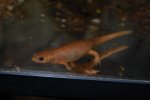Please read the following info before voting...
I am conducting a little experiment. I have a breeding group of C. cyanurus. In 2010, I raised about 200 offspring. As usual for this species, they were highly variable in color.

I picked out the 6 lightest and 6 darkest individuals. I have the two groups housed separately, and will allow them to breed.
What will be the outcome? Will the color follow some kind of typical genetic inheritance? Or will both groups have the same full spectrum of colors in their offspring? Take a guess, and I'll give you the answer in a year or two!
Here are photos of the two color-selected groups.




I am conducting a little experiment. I have a breeding group of C. cyanurus. In 2010, I raised about 200 offspring. As usual for this species, they were highly variable in color.

I picked out the 6 lightest and 6 darkest individuals. I have the two groups housed separately, and will allow them to breed.
What will be the outcome? Will the color follow some kind of typical genetic inheritance? Or will both groups have the same full spectrum of colors in their offspring? Take a guess, and I'll give you the answer in a year or two!
Here are photos of the two color-selected groups.













